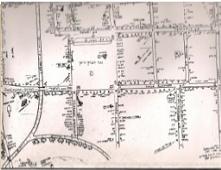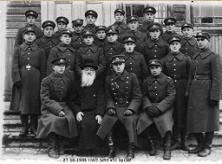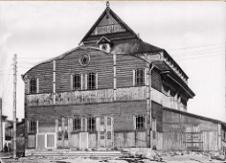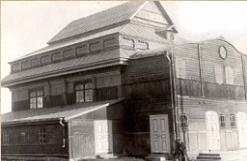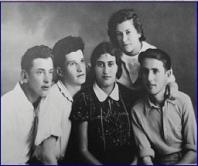Under German Occupation 1941 - 1944
VILKAVISKIS
A small town in Southern Lithuania
Where the Jewish Community is no more

At dawn on June 22, 1941, Vilkovishk was bombed by the German Air Force, the center of the town was ruined, and most of the Jewish houses including the old synagogue went up in flames. This was the beginning of the German invasion of the USSR. Most of the Jews who had fled from the bombed town returned and crowded together into the remaining undamaged houses. The German army entered Vilkovishk on the first day of the invasion, but the Lithuanian nationalists did not wait for orders from the Germans and started plotting against the Jews immediately. They robbed Jewish houses, guided Germans into Jewish houses and told them to take anything they wanted. Two days later, on June 24, 1941, all Jewish men were ordered to gather in the market place, from which they were sent in groups to various types of work, such as cleaning the streets of ruins, collecting dead Russian soldiers and burying them, and other duties for units of the German army. Some groups were sent to nationalized agricultural farms.
Because Vilkovishk was situated within 25 km of the German border, the decision on the fate of the Jews was handed over to the Gestapo in Tilzit, where an order was issued to clean the area of Jews and communists. Jews were ordered to wear a yellow patch on their garments and were forbidden to walk on sidewalks. Every day communists were hunted down, and this was used as a pretext to detain Jews, who had no contact with communist activities.
One night at the beginning of July, on orders from the Tilzit Gestapo, all Jewish men, except for the ill, were taken from their homes and led by Lithuanian policemen to the building of the Priests Seminar outside the town. There the policemen stood in two lines on both sides of the stairs, and the Jews had to walk between them where they were badly beaten with sticks and iron bars. Three men who tried to resist were killed immediately, one of them being Yosef Tchihak. They were buried in the yard of the Seminar.
After a week or so the men from the Seminar, which included the sick who had been left in town previously, were transferred to a barracks outside the town which was encircled with barbed wire and was proclaimed a Ghetto. A committee of four men was appointed - "The Committee of the Jews".
On July 27, 1941 the Ghetto was surrounded in force by Lithuanian guards. In order not to arouse panic and to prevent attempts to escape, the guards soothed the Jews, telling them that nothing bad would happen to them. The commander of the guard gathered 250 Jewish men, equipped them with spades, took them to the training yard of the barracks and ordered them to dig ditches. The explanation was that there was an urgent need to store oil tanks in the ground. The duplicity of this commander was so shocking that he summoned one of the Jewish men, who had once dealt with oil issues, and asked him if the ditches would be suitable for that purpose. All the men returned home that evening.
The next day, July 28, 1941 (fourth of Av 5701) 800 men, including 65 non-Jewish Communists were taken to this yard, where they were ordered to remove their clothes, after which they were shot and buried in the previously prepared ditches. Back in town people could not believe that the men had been killed, as rumours were spread that the men had been transferred to another working place. Those women who still lived in town and came to visit their husbands bringing food parcels, approached the German commander asking about the fate of the men. He soothed their fears and received money and valuables from them, promising to clarify the whereabouts of their menfolk.
On the first of August all the women and children who still lived in town were forced to move to the barracks. Everyone was allowed to take belongings of up to 25 kg and 250 Rubel. The women immediately discovered the mass graves, despite the fact that the yard had been leveled and there were no signs left. The Lithuanian guard forbade the women to approach the site. There were two ditches in the yard, one 20 meters long and 5 m wide and the other 14 m long and 3 m wide, and near them another empty ditch.
On September 24, 1941 (third of Tishrei 5702 - Tsom Gedaliah) the women and children were murdered too. Many escaped but were caught later. Only two young sisters, from the Faktorovsky family survived and were hidden by a Lithuanian woman (named Juziene) in a small village 9 km from Vilkovishk. This woman saved the sisters for humane motives only, and did not receive any reward for her deed.
According to official Soviet data, 3,056 people were murdered in Vilkovishk by the Germans and their local helpers during June-September 1941.














